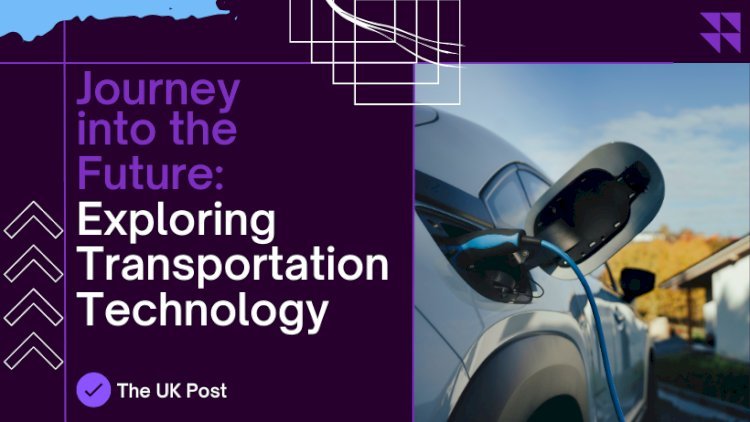Journey into the Future: Exploring Transportation Technology
Explore the latest advancements in transportation technology, including electric vehicles, autonomous cars, hyperloops, drones, and more, reshaping the future of mobility.

Transportation technology is evolving at an incredible pace, fundamentally transforming how we move people and goods. From electric vehicles and autonomous cars to hyperloops and drones, innovation in transportation technology is solving challenges like traffic congestion, pollution, and access to safe travel. These advancements are not only making travel faster and more convenient but also more sustainable and accessible. In this article, we will explore the most significant developments in transportation technology and how they are reshaping the future of mobility.
Electric Vehicles (EVs): Driving Towards a Sustainable Future

Electric vehicles (EVs) have emerged as one of the most impactful advancements in transportation technology. With the push for sustainable energy and the need to reduce carbon emissions, EVs are becoming increasingly popular across the globe. Companies like Tesla, Nissan, and Chevrolet are leading the charge by producing efficient and affordable electric cars. As governments incentivize EV adoption through subsidies and tax benefits, the future looks bright for greener transportation.
- Electric vehicles produce zero tailpipe emissions.
- The cost of batteries is decreasing, making EVs more affordable.
- EV charging infrastructure is expanding rapidly.
Autonomous Vehicles: The Age of Self-Driving Cars

Self-driving cars represent a massive leap in transportation technology, promising to enhance road safety and reduce accidents caused by human error. Autonomous vehicles use sensors, AI, and real-time data to navigate roads without human intervention. Companies like Waymo and Uber are already testing autonomous taxis, and many believe that self-driving cars could dominate the roads within the next decade.
- Autonomous vehicles can reduce traffic accidents by up to 90%.
- Self-driving cars improve fuel efficiency by optimizing routes.
- These vehicles can provide greater mobility for elderly and disabled individuals.
Hyperloop: The Future of High-Speed Travel

The hyperloop is an ambitious transportation concept that could revolutionize long-distance travel. Proposed by Elon Musk and being developed by companies like Virgin Hyperloop, this technology involves pods traveling through low-pressure tubes at incredible speeds. The hyperloop could cut travel time between cities dramatically, making it possible to commute between distant locations in minutes rather than hours.
- Hyperloop technology can reach speeds of up to 760 mph.
- It is powered by renewable energy, reducing the carbon footprint of long-distance travel.
- The technology has the potential to reshape urban planning and regional connectivity.
Drones and Aerial Mobility: Taking to the Skies

Drones are no longer just for recreational use; they are rapidly becoming a viable transportation option for delivering goods and even passengers. Companies like Amazon and UPS are investing in drone delivery systems to make shipping faster and more efficient. Additionally, the concept of flying taxis is gaining traction, with companies like Joby Aviation working on electric vertical take-off and landing (eVTOL) vehicles.
- Drones can reduce delivery times in urban areas by avoiding road traffic.
- Aerial taxis could become a solution to urban congestion.
- Advances in battery technology are making longer drone flights possible.
Maglev Trains: High-Speed Rail Reimagined

Magnetic levitation (maglev) trains use powerful magnets to lift and propel the train, reducing friction and allowing for incredibly high speeds. Maglev technology is already in use in countries like Japan and China, with trains reaching speeds of over 300 mph. As this technology continues to improve, maglev trains could become a key component of future transportation networks, providing an alternative to both air travel and traditional rail.
- Maglev trains have lower maintenance costs due to fewer moving parts.
- They produce less noise and pollution compared to conventional trains.
- Maglev technology is energy-efficient, relying on electromagnetic forces.
Smart Infrastructure: Enhancing Transportation Efficiency

Transportation technology isn’t just about vehicles; smart infrastructure plays a critical role in optimizing travel. Smart cities are integrating technologies like IoT (Internet of Things) sensors, AI, and big data analytics to manage traffic flow, reduce congestion, and enhance safety. These systems can monitor road conditions in real-time and adjust traffic signals to ensure smoother and faster journeys.
- Smart traffic lights can reduce commute times by optimizing traffic flow.
- IoT sensors can detect road damage and notify maintenance crews immediately.
- Data from smart infrastructure can help city planners improve urban mobility.
Sustainable Public Transport: Green Solutions for Urban Areas

Sustainable public transportation solutions, such as electric buses and trams, are becoming a priority for cities looking to reduce their environmental impact. By investing in electric public transport, cities can cut down on pollution and create more efficient and reliable transit systems. Governments are increasingly funding projects that support the electrification of public transport fleets.
- Electric buses reduce greenhouse gas emissions and improve air quality.
- Modern trams and buses are quieter and more energy-efficient.
- Investment in public transport encourages the use of mass transit over private vehicles.
Shared Mobility: Changing the Way We Travel

Shared mobility services, such as ride-sharing and bike-sharing platforms, are gaining popularity as urban populations grow and space becomes limited. Companies like Uber, Lyft, and Lime are leading the way by providing alternatives to traditional car ownership. These services are not only convenient but also contribute to reducing the number of vehicles on the road, alleviating traffic congestion, and lowering emissions.
- Ride-sharing reduces the number of cars on the road.
- Bike-sharing provides an eco-friendly alternative for short trips.
- Shared mobility services are flexible and affordable for users.
Conclusion
Transportation technology is rapidly evolving, offering solutions to some of the most pressing issues in mobility, such as sustainability, efficiency, and accessibility. From electric and autonomous vehicles to hyperloops and drones, these advancements are transforming the way we move. As we continue to innovate and integrate new technologies, the future of transportation looks faster, greener, and more interconnected.
FAQ
Q1: What is transportation technology?
A: Transportation technology encompasses innovations that improve the efficiency, sustainability, and safety of how people and goods move. This includes electric vehicles, self-driving cars, and smart infrastructure.
Q2: How will electric vehicles impact the environment?
A: Electric vehicles reduce greenhouse gas emissions by eliminating tailpipe pollutants, contributing to cleaner air and a lower carbon footprint.
Q3: What is a hyperloop?
A: A hyperloop is a proposed high-speed transportation system in which pods travel through low-pressure tubes at speeds of up to 760 mph.
Q4: Are drones used for transportation?
A: Yes, drones are increasingly used for delivering goods and are being developed for passenger transport through aerial mobility concepts like flying taxis.
Q5: What are maglev trains?
A: Maglev trains use magnetic levitation to glide above tracks at high speeds with minimal friction, offering an energy-efficient alternative to traditional rail.

















